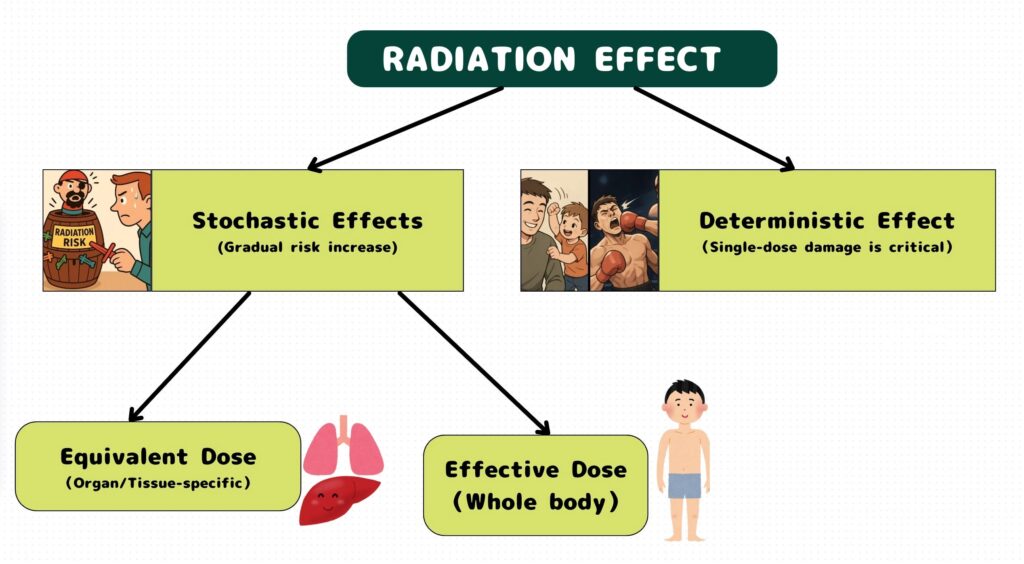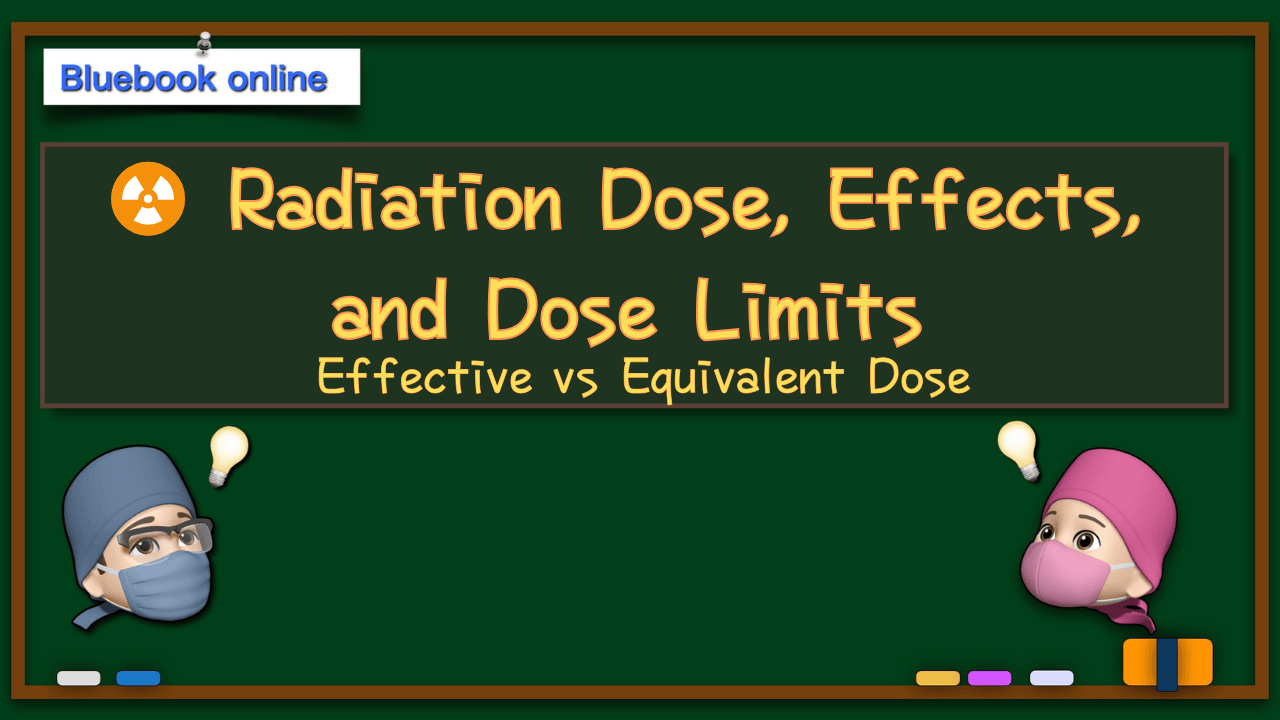👉👉 🇺🇸 All Posts 🇬🇧 / 🇯🇵 記事一覧 🇯🇵 👈👈
Contents
♦️ Radiation Dose, Effects, and Dose Limits: Effective vs Equivalent Dose
When we think about how radiation affects the body, there are two main types of effects:
- Deterministic effects : damage that only appears above a certain threshold dose, and severity increases as dose increases. Examples include cataracts (in the lens of the eye), infertility, or fetal malformations.
- Stochastic effects : no sharp threshold, but risk increases cumulatively with dose. Examples are cancer induction and genetic (heritable) effects.
To measure and regulate these risks, two dose metrics are key:
- Equivalent dose: the radiation dose to a particular organ or tissue, adjusted for type of radiation.
- Effective dose: combines equivalent doses across various organs/tissues (with weighting for sensitivity) to estimate whole‐body risk.
In medical contexts, healthcare workers are under regulatory dose limits designed to protect against both deterministic and stochastic effects. These limits differ by country; I’ll compare U.S./ICRP with Japanese regulations where possible.

♦️ Key Terms and Thresholds
🔷 Threshold for deterministic damage (e.g. cataract in lens of eye)
- Recent ICRP evidence suggests that the threshold for eye lens damage (leading to cataracts) is about 0.5 Gy (500 mGy). Below this, damage may appear as opacity without functional impairment; above, risk increases.
🔷 Fetal sensitivity
- A fetal exposure of 100 mGy or more is often cited as a threshold for certain deterministic effects (e.g. malformation).
- However, because the fetus is protected by maternal tissues, reaching that dose requires significantly higher maternal exposure. Routine medical care with proper shielding rarely approaches such levels.
Dose Limits in Japan vs U.S./ICRP
| Limit Type | Japan (medical/occupational) | ICRP (International) and U.S. Regulations |
| Effective dose (occupational) | 100 mSv / 5 years and no more than 50 mSv in any one year; for women of reproductive age 5 mSv per 3 months | ICRP recommends 20 mSv/year averaged over 5 years, with no single year exceeding 50 mSv for occupational exposure. U.S. NRC & DOE follow limits |
| Equivalent dose: lens of the eye | 50 mSv/year | ICRP: 20 mSv/year, averaged over 5 years, with a max of 50 mSv in any single year. U.S. (NRC): Still often 150 mSv/year, though adoption of ICRP values is increasing. |
| Equivalent dose: skin / extremities | high limits (e.g. 500 mSv/年 for skin) | 500 mSv/year. |
| Public & pregnancy‐related limits | e.g. abdomen surface of pregnant female workers 2 mSv during pregnancy | ICRP recommends 1 mSv/year effective dose for the general public. For declared pregnant worker, some U.S. regulations set embryo/fetal exposure limit around 5 mSv over the remainder of pregnancy. |
☝️ References & Links
- ICRPaedia – Dose Limits (ICRP) https://icrpaedia.org/Dose_limits
- NCBI – Radiation Exposure and Dose Limits https://www.ncbi.nlm.nih.gov/books/NBK586450/
- ICRP Publication 139 (Eye Lens Dose Reduction) https://www.icrp.org/publication.asp?id=ICRP+Publication+139
- Stanford University – Maximum Permissible Occupational Doses https://ehs.stanford.edu/manual/radiation-protection-guidance-hospital-staff/maximum-permissible-occupational-doses
- Environmental Health and Safety – Oregon State University Radiation Safety Manual https://ehs.oregonstate.edu/rso/rsm-05
♦️ Practical Implications for Medical Staff & Trainees
- Even though limit values may seem large, in most clinical settings with proper protective measures (lead aprons, shields, limited exposure times) actual doses are far below those limits.
- Eye lenses are more vulnerable than previously thought; the reduction of lens dose limits by ICRP (to ~20 mSv/year) reflects newer data. In interventional radiology / fluoroscopy, monitoring and protection for eyes are especially important.
- For pregnant workers, employers often have legal duty to limit exposure. In the U.S., once pregnancy is declared, extra protections may reduce allowable exposure to the embryo/fetus. Similar in Japan in many hospitals. It’s good practice to know your institution’s policy.
♦️ Summary (for US/International + Japan)
- Equivalent dose = dose to a specific organ, adjusted for radiation type; relevant for deterministic effects like cataracts, skin damage, etc.
- Effective dose = weighted sum of organ doses = best measure of risk for stochastic effects across the body.
- Stay aware of which country’s limits apply (your workplace may follow Japanese law, ICRP, U.S. NRC, or others). Especially for lens of eye, skin, pregnancy etc., the U.S./ICRP limits can differ vs Japanese values.
- Key numbers to remember (comparison):
- Effective dose occupational: ~20 mSv/year (ICRP) vs ~50 mSv/year (U.S. NRC / Japanese equivalent) depending on context.
- Lens of eye: ~20 mSv/year (ICRP reduced), previously 150 mSv in many places.
- Skin/extremity: ~500 mSv/year shallow/skin dose.
- Public exposure: ~1 mSv/year effective dose.

コメントを投稿するにはログインしてください。